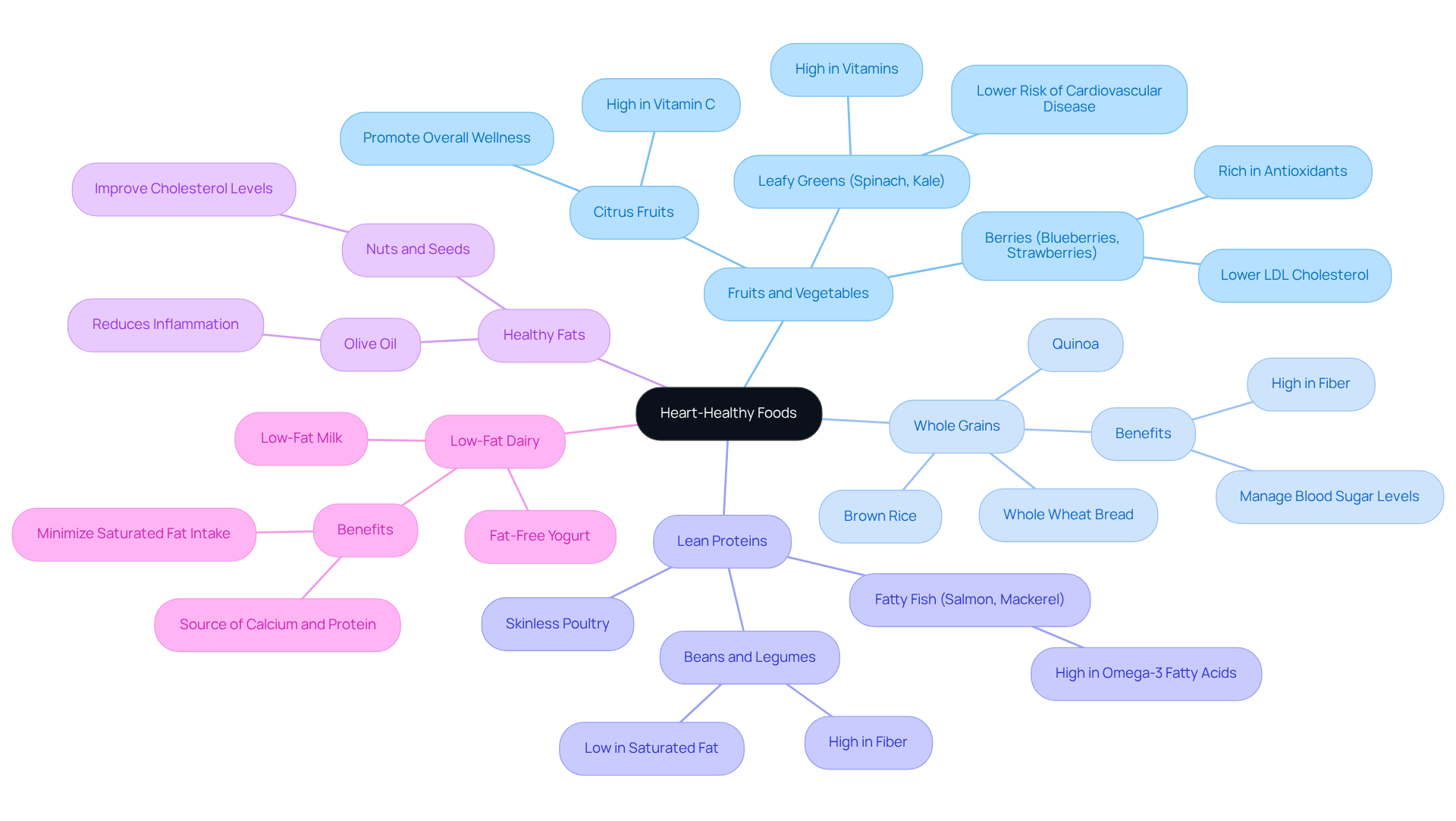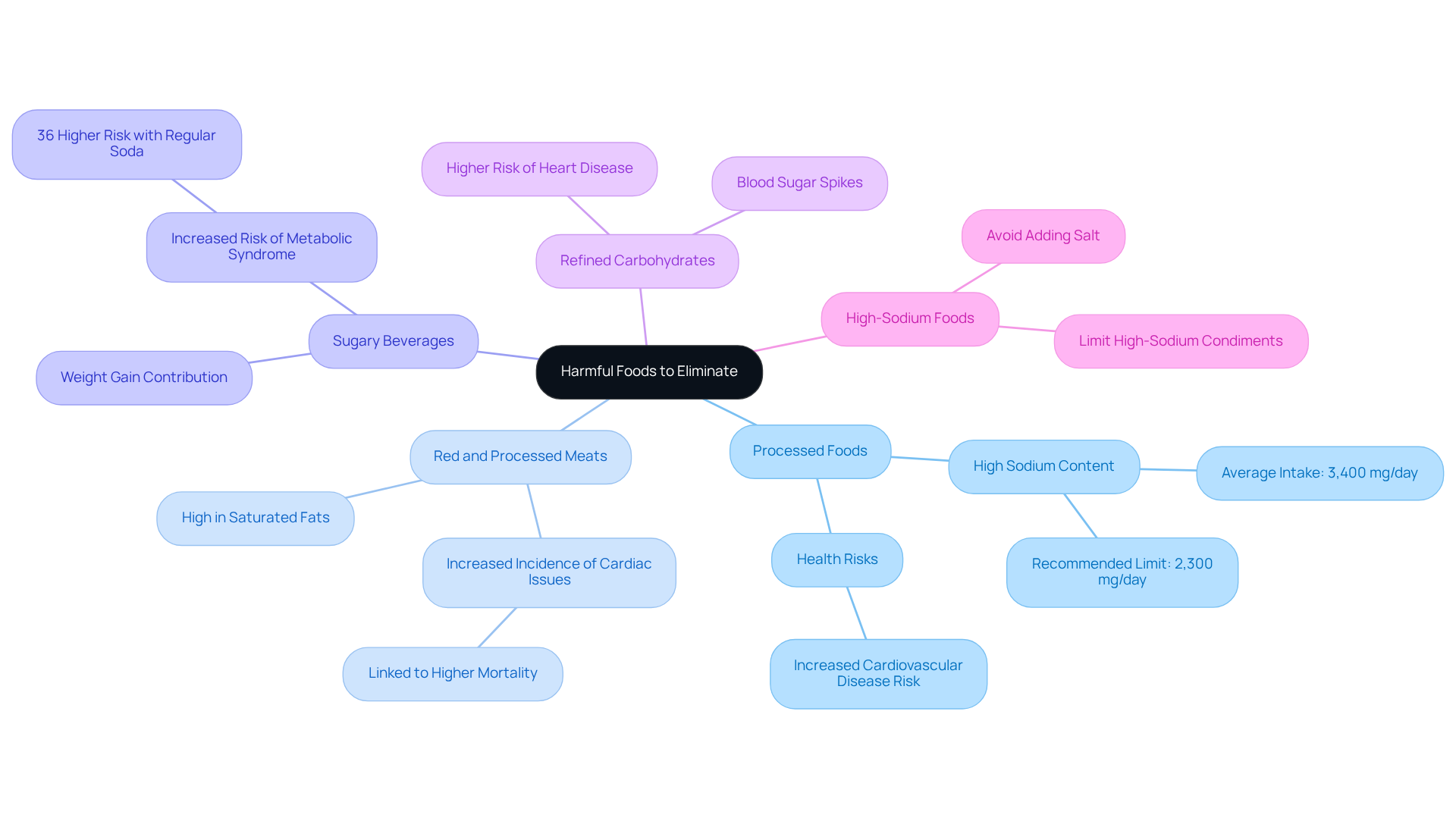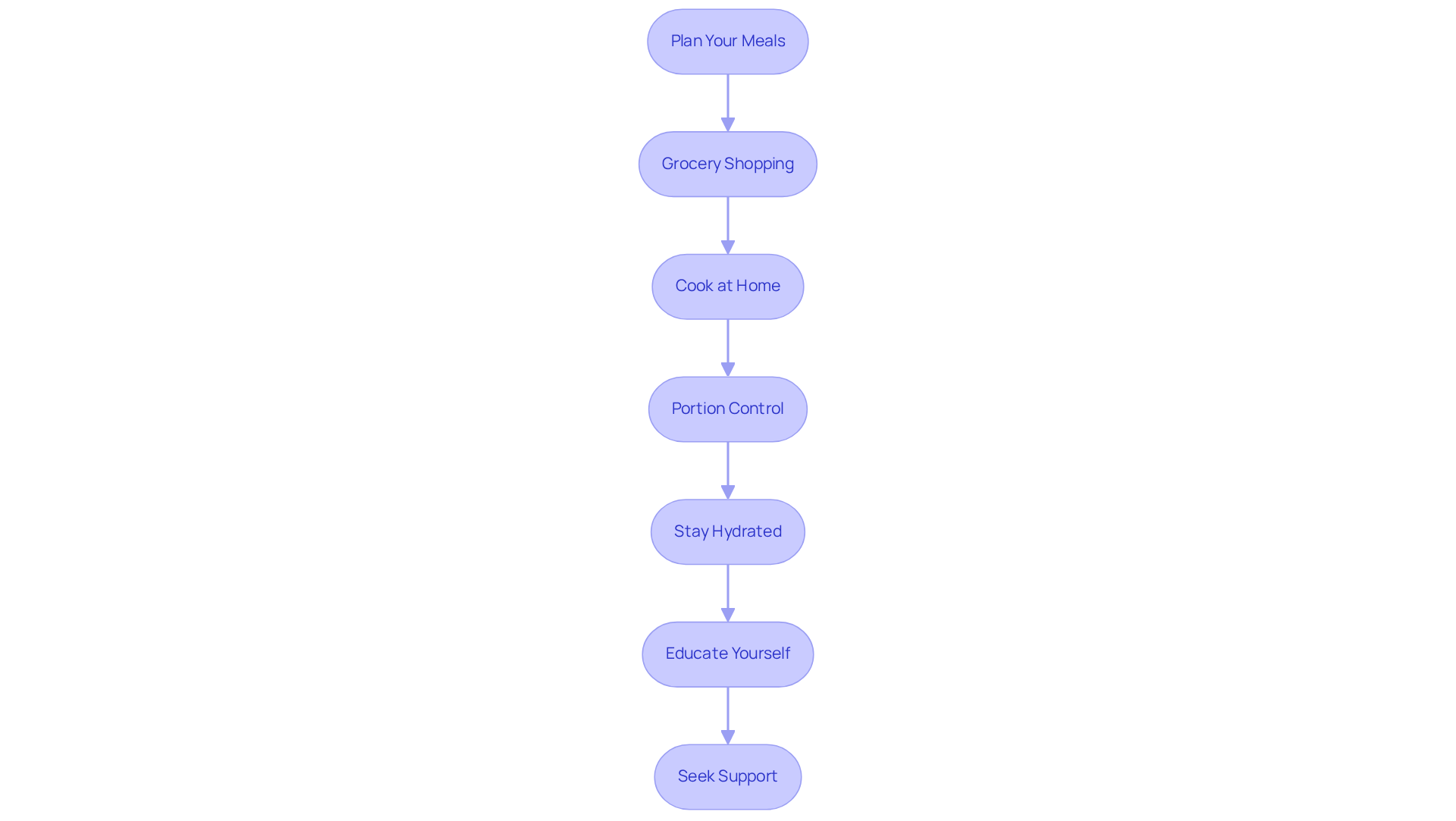


A growing body of research highlights just how vital diet is for maintaining heart health. For those looking to enhance their well-being, focusing on a cardiac diet can be a game changer. This nutritional approach not only encourages the inclusion of heart-healthy foods but also stresses the importance of steering clear of harmful options that could jeopardize cardiovascular function.
But with so much information out there, how can you navigate the complexities of adopting a cardiac diet? It’s completely understandable to feel overwhelmed. Exploring the principles, benefits, and practical steps of this dietary plan can reveal a pathway to a healthier heart and a more vibrant life. Remember, you’re not alone in this journey; support is available, and taking small steps can lead to significant changes.
The cardiac diet pdf highlights a cardiovascular-friendly eating plan that emphasizes choosing foods to support heart health while minimizing those that could lead to heart issues. Let’s explore some key principles that can make a significant difference in your well-being:
Low Sodium Intake: Reducing sodium is essential for managing blood pressure, a crucial factor in heart health. Did you know that most people consume over ten times the sodium they actually need? Much of this sodium comes from packaged and processed foods rather than added salt. Studies show that a diet low in sodium can effectively lower blood pressure, which in turn reduces cardiovascular risk.
Healthy Fats: It’s important to prioritize unsaturated fats found in olive oil, avocados, and nuts over saturated and trans fats typically found in red meat and processed foods. Making this switch can significantly lower cholesterol levels. According to the Heart Foundation, 'A low-saturated fat, high-fibre, high plant food regimen can significantly lower the risk of developing cardiovascular illness.'
High Fiber: Incorporating whole grains, fruits, and vegetables into your diet boosts fiber intake, which is beneficial for heart health. A diet rich in soluble fiber can help lower total cholesterol levels and improve overall cardiovascular function.
Lean Proteins: Choosing lean meats, fish, and plant-based proteins supports heart function without the excess saturated fat. Regularly including these proteins in your meals can help maintain a healthy weight and reduce the risk of cardiovascular illness. The Heart Foundation suggests limiting unprocessed red meats to a maximum of 350 g per week.
The importance of this nutritional plan cannot be overstated. Following the guidelines outlined in a cardiac diet PDF can lower the risk of cardiovascular issues, reduce cholesterol levels, and enhance your overall well-being. Nutritionists emphasize that a low-sodium, high-fiber eating plan rich in healthy fats and lean proteins is vital for maintaining heart function and preventing chronic illnesses.
Real-life examples show that individuals who adopt a low-sodium eating plan often experience significant improvements in blood pressure and overall heart health. This reinforces the benefits of making these thoughtful nutritional choices. Remember, you’re not alone on this journey; seeking support and guidance can lead to a healthier, happier life.

To successfully implement a cardiac diet pdf, it’s important to focus on incorporating a variety of heart-healthy foods that promote cardiovascular wellness.
Fruits and Vegetables: Aim for a colorful assortment to maximize nutrient intake. Berries, like blueberries and strawberries, are rich in antioxidants that may help lower LDL cholesterol and blood pressure. Leafy greens such as spinach and kale are linked to a lower risk of cardiovascular disease and stroke, making them essential for your heart health. Citrus fruits, packed with vitamin C, also contribute to overall cardiovascular well-being. Research shows that boosting your fruit and vegetable consumption can significantly lower the risk of coronary artery disease (RR 0.92) and stroke (RR 0.84).
Whole Grains: Including foods like brown rice, quinoa, and whole wheat bread can be beneficial. These grains are excellent sources of fiber and essential nutrients. They assist in managing blood sugar levels and promote cardiovascular well-being by reducing cholesterol.
Lean Proteins: Consider incorporating skinless poultry, fish (especially fatty fish like salmon and mackerel), beans, and legumes into your meals. These protein sources are low in saturated fat and high in omega-3 fatty acids, which are advantageous for your heart health. Additionally, increasing plant-based proteins is encouraged, as current guidelines suggest reducing red and processed meat intake.
Healthy Fats: Using olive oil for cooking and including nuts and seeds in your snacks can be a great choice. These healthy fats help reduce inflammation and improve cholesterol levels.
Low-Fat Dairy: Opt for low-fat or fat-free options to minimize saturated fat intake while still benefiting from essential nutrients like calcium and protein. Current guidelines recommend keeping saturated fats under 10% of daily calories for optimal cardiovascular well-being.
These items not only promote cardiovascular wellness but also enhance your overall well-being, making them crucial elements found in a cardiac diet pdf. By focusing on these heart-healthy options, you can take significant steps toward improving your cardiovascular health and quality of life. Remember, you’re not alone on this journey; support is always available.

To maintain a heart-healthy diet, it’s essential to gently eliminate some harmful foods that can affect your well-being:
Processed Foods: These items often come packed with high levels of sodium, unhealthy fats, and added sugars. Quick meals, packaged treats, and frozen dishes can significantly increase your risk of cardiovascular disease. Did you know that Americans consume an average of 3,400 milligrams of sodium each day through processed items? That’s well above the recommended limit set by the American Heart Association.
Red and Processed Meats: It’s wise to limit your intake of red meats and processed meats, like bacon, sausages, and deli meats. These foods are typically high in saturated fats and sodium, both linked to a higher risk of heart disease. Research shows that those who consume large amounts of processed meats face a greater incidence of cardiac issues. A study published in the American Journal of Clinical Nutrition even connects higher processed meat consumption to increased mortality and cardiovascular disease risk.
Sugary Beverages: Soft drinks and energy drinks can contribute to weight gain and are associated with an increased risk of cardiovascular disease. Regularly consuming these beverages may lead to metabolic syndrome, raising the likelihood of heart issues. In fact, regular soda intake might increase your risk of metabolic syndrome by 36%, according to registered nutritionist Arika Hoscheit. Choosing water instead of sugary drinks can significantly benefit your heart health.
Refined Carbohydrates: Foods like white bread, pastries, and sugary cereals can cause spikes in blood sugar levels, leading to weight gain and increasing your risk of cardiovascular disease. Research indicates that diets high in refined grains are linked to a higher risk of heart disease compared to those rich in whole grains.
High-Sodium Foods: It’s advisable to avoid adding salt to your meals and to limit high-sodium condiments and snacks. The American Heart Association recommends a daily sodium cap of 2,300 milligrams, ideally not exceeding 1,500 milligrams, to help reduce hypertension and cardiovascular disease risk.
By removing these foods from your diet, as suggested in the cardiac diet pdf, you can significantly lower your risk of cardiovascular issues and enhance your overall well-being. Many individuals who follow a plan low in red and processed meats often report improved cardiovascular health, highlighting the importance of mindful food choices in managing heart health. Remember, you’re not alone in this journey, and making these changes can lead to a healthier, happier life.

Implementing a cardiac diet can be a gentle journey with these practical steps:
Plan Your Meals: Start by creating a weekly meal plan filled with heart-healthy options. This simple act can help you avoid those last-minute unhealthy choices that often creep in. Did you know that 77% of Americans wish to have a healthier diet? Meal planning is a crucial step toward achieving that goal.
Grocery Shopping: When you head to the store, make a shopping list focused on whole foods. Try to steer clear of the aisles filled with processed products. Stick to the perimeter of the store, where fresh produce and lean proteins are usually found. The Clean Label Movement is gaining momentum, with many people preferring products free from artificial ingredients.
Cook at Home: Preparing meals at home gives you better control over what goes into your food and the portion sizes. Why not experiment with heart-healthy recipes? As Ann Wigmore wisely said, "The sustenance you consume can be either the safest and most potent form of medicine, or the slowest form of poison."
Portion Control: Consider using smaller plates to help manage your portion sizes and prevent overeating. This small change can significantly impact your overall caloric intake.
Stay Hydrated: Remember to drink plenty of water and limit sugary drinks. Herbal teas can also be a delightful alternative. Staying hydrated is essential for your overall health and can help curb those unnecessary snack cravings.
Educate Yourself: Take the time to read product labels and understand what you’re consuming, especially focusing on sodium, fat, and sugar content. Many people find food labels confusing, so familiarizing yourself with them can be empowering.
Seek Support: Don’t hesitate to consider joining a support group or working with a dietitian. Having someone to share your journey with can provide motivation and accountability. Engaging with others can also offer encouragement and valuable grocery shopping strategies.
By following these steps, you can successfully adopt a cardiac diet that promotes heart health and overall well-being. As Jim Rohn wisely stated, "Take care of your body. It's the only place you have to live." Embracing this mindset can inspire a lasting commitment to healthier eating habits.

Adopting a cardiac diet is a meaningful step toward enhancing your heart health and overall well-being. This approach emphasizes the importance of choosing nutrient-rich foods while minimizing those that could harm your cardiovascular function. By focusing on low sodium intake, healthy fats, high fiber, and lean proteins, you can significantly reduce your risk of cardiovascular diseases, improve your cholesterol levels, and foster a healthier lifestyle.
Have you considered the heart-healthy foods that can make a difference? Incorporating fruits, vegetables, whole grains, and lean proteins into your meals is essential, while it’s wise to avoid processed foods, red meats, and sugary beverages. Practical steps like meal planning, intentional grocery shopping, and seeking support can help you transition smoothly to this dietary plan. Remember, the benefits of embracing a cardiac diet extend beyond your individual health; they contribute to a broader movement toward better public health and awareness.
Ultimately, your journey to heart health through a cardiac diet is not just about making dietary changes; it’s about committing to a lifestyle that prioritizes your well-being. Taking actionable steps today can lead to lasting benefits for both your heart and body. Embrace this opportunity to make informed food choices and create a supportive environment around you. These efforts can pave the way for a healthier, more vibrant life. You’re not alone in this journey; support is available, and every small step counts.
What is the cardiac diet?
The cardiac diet is a cardiovascular-friendly eating plan that emphasizes choosing foods that support heart health while minimizing those that could lead to heart issues.
Why is low sodium intake important in the cardiac diet?
Reducing sodium is essential for managing blood pressure, which is crucial for heart health. A diet low in sodium can effectively lower blood pressure and reduce cardiovascular risk.
What types of fats should be prioritized in the cardiac diet?
The cardiac diet emphasizes prioritizing unsaturated fats found in foods like olive oil, avocados, and nuts, while minimizing saturated and trans fats typically found in red meat and processed foods.
How does fiber intake relate to heart health?
Incorporating whole grains, fruits, and vegetables boosts fiber intake, which is beneficial for heart health. A diet rich in soluble fiber can help lower total cholesterol levels and improve overall cardiovascular function.
What types of proteins are recommended in the cardiac diet?
The cardiac diet encourages choosing lean meats, fish, and plant-based proteins to support heart function without excess saturated fat. It's recommended to limit unprocessed red meats to a maximum of 350 g per week.
What are the overall benefits of following a cardiac diet?
Following the cardiac diet can lower the risk of cardiovascular issues, reduce cholesterol levels, and enhance overall well-being. It is vital for maintaining heart function and preventing chronic illnesses.
Can individuals see real-life improvements by adopting a cardiac diet?
Yes, individuals who adopt a low-sodium eating plan often experience significant improvements in blood pressure and overall heart health, reinforcing the benefits of making thoughtful nutritional choices.